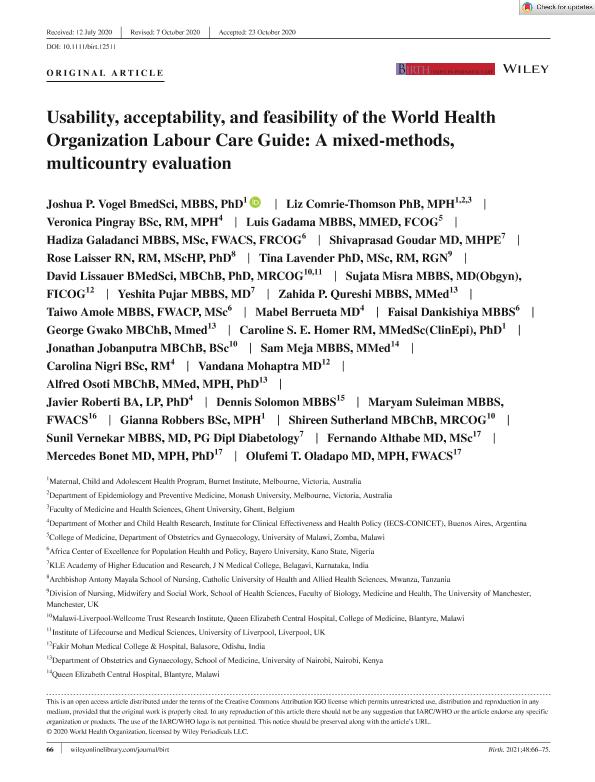Artículo
Usability, acceptability, and feasibility of the World Health Organization Labour Care Guide: A mixed-methods, multicountry evaluation
Vogel, Joshua P.; Comrie-Thomson, Liz; Pingray, María Verónica; Gadama, Luis; Galadanci, Hadiza; Goudar, Shivaprasad; Laisser, Rose; Lavender, Tina; Lissauer, David; Misra, Sujata; Pujar, Yeshita; Qureshi, Zahida P.; Amole, Taiwo; Berrueta, Amanda Mabel; Dankishiya, Faisal; Gwako, George; Homer, Caroline S. E.; Jobanputra, Jonathan; Meja, Sam; Nigri, Carolina; Mohaptra, Vandana; Osoti, Alfred; Roberti, Javier Eugenio ; Solomon, Dennis; Suleiman, Maryam; Robbers, Gianna; Sutherland, Shireen; Vernekar, Sunil; Althabe, Fernando
; Solomon, Dennis; Suleiman, Maryam; Robbers, Gianna; Sutherland, Shireen; Vernekar, Sunil; Althabe, Fernando ; Bonetto, Mercedes; Oladapo, Olufemi T.
; Bonetto, Mercedes; Oladapo, Olufemi T.
 ; Solomon, Dennis; Suleiman, Maryam; Robbers, Gianna; Sutherland, Shireen; Vernekar, Sunil; Althabe, Fernando
; Solomon, Dennis; Suleiman, Maryam; Robbers, Gianna; Sutherland, Shireen; Vernekar, Sunil; Althabe, Fernando ; Bonetto, Mercedes; Oladapo, Olufemi T.
; Bonetto, Mercedes; Oladapo, Olufemi T.
Fecha de publicación:
03/2021
Editorial:
Wiley Blackwell Publishing, Inc
Revista:
Birth-issues in Perinatal Care
ISSN:
0730-7659
e-ISSN:
1523-536X
Idioma:
Inglés
Tipo de recurso:
Artículo publicado
Clasificación temática:
Resumen
Introduction: The World Health Organization’s (WHO) Labour Care Guide (LCG) is a “next-generation” partograph based on WHO’s latest intrapartum care recommendations. It aims to optimize clinical care provided to women and their experience of care. We evaluated the LCG’s usability, feasibility, and acceptability among maternity care practitioners in clinical settings. Methods: Mixed-methods evaluation with doctors, midwives, and nurses in 12 health facilities across Argentina, India, Kenya, Malawi, Nigeria, and Tanzania. Purposively sampled and trained practitioners applied the LCG in low-risk women during labor and rated experiences, satisfaction, and usability. Practitioners were invited to focus group discussions (FGDs) to share experiences and perceptions of the LCG, which were subjected to framework analysis. Results: One hundred and thirty-six practitioners applied the LCG in managing labor and birth of 1,226 low-risk women. The majority of women had a spontaneous vaginal birth (91.6%); two cases of intrapartum stillbirths (1.63 per 1000 births) occurred. Practitioner satisfaction with the LCG was high, and median usability score was 67.5%. Practitioners described the LCG as supporting precise and meticulous monitoring during labor, encouraging critical thinking in labor management, and improving the provision of woman-centered care. Conclusions: The LCG is feasible and acceptable to use across different clinical settings and can promote woman-centered care, though some design improvements would benefit usability. Implementing the LCG needs to be accompanied by training and supportive supervision, and strategies to promote an enabling environment (including updated policies on supportive care interventions, and ensuring essential equipment is available).
Palabras clave:
CHILDBIRTH
,
INTRAPARTUM CARE
,
LABOR
,
PARTOGRAPH
,
WHO LABOUR CARE GUIDE
Archivos asociados
Licencia
Identificadores
Colecciones
Articulos(CIESP)
Articulos de CENTRO DE INVESTIGACIONES EN EPIDEMIOLOGIA Y SALUD PUBLICA
Articulos de CENTRO DE INVESTIGACIONES EN EPIDEMIOLOGIA Y SALUD PUBLICA
Citación
Vogel, Joshua P.; Comrie-Thomson, Liz; Pingray, María Verónica; Gadama, Luis; Galadanci, Hadiza; et al.; Usability, acceptability, and feasibility of the World Health Organization Labour Care Guide: A mixed-methods, multicountry evaluation; Wiley Blackwell Publishing, Inc; Birth-issues in Perinatal Care; 48; 1; 3-2021; 66-75
Compartir
Altmétricas



